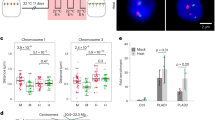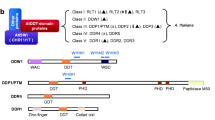Abstract
Matrix attachment regions (MARs) are thought to participate in the organization and segregation of independent chromosomal loop domains. Although there are several reports on the action of MARs in the context of heterologous genes, information is more limited on the role of MARs associated with plant genes. Transgenic studies suggest that the upstream, intron and downstream regions of the developmentally regulated heat shock cognate 80 gene (HSC80) of tomato participate in chromatin organization. In this study, we tested the in vitro affinity of the HSC80 gene to chromosomal scaffolds prepared from shoot apices of tomato. We found that a 1.5 kb upstream region and a 1.4 kb downstream region, but not the intron region, are MARs. These MARs interact with tomato and pea scaffolds and bind regardless of the expression status of HSC80 in the tissue from which the nuclei were isolated. Comparison to two known yeast MARs ARS1 and CENIII, showed that the HSC80 5′MAR binds more avidly to tomato scaffolds than ARS1, while no binding of CENIII was observed. Competition binding between the two HSC80 MARs indicated that the 5′ MAR can outcompete the 3′ MAR and not vice versa. Last, we observed that the interaction of the 3′ MAR with the scaffold could result in an electrophoretic mobility shift resistant to SDS, protease, and phenol treatment. In conclusion, MARs whose binding properties can be clearly differentiated are closely flanking the HSC80 gene. The discovery of MARs in regions which have a distinct function in HSC80 transgenes but not in transient expression assays, is consistent with a chromosomal scaffold role in HSC80 gene regulation.
Similar content being viewed by others
References
Allen GC, Hall GEJ, Childs LC, Weissinger AK, Spiker S, Thompson WF. Scaffold attachment regions increase reporter gene expression in stably transformed plant cells. Plant Cell 5: 603–613 (1193).
Amati B, Gasser SM: Drosophila scaffold-attached regions bind nuclear scaffolds and can function as ARS elements in both budding and fission yeasts. Mol Cell Biol 10: 5442–5454 (1990).
Amati BB, Gasser SM: Chromosomal ARS and CEN elements bind specifically to the yeast nuclear scaffold. Cell 54: 967–978 (1988).
Ariizumi K, Wang Z, Tucker PW: Immunoglobulin heavy chain enhancer is located near or in an initiation zone of chromosomal DNA replication. Proc Natl Acad Sci USA 90: 3695–3699 (1993).
Avramova Z, Bennetzen JL: Isolation of matrices from maize leaf nuclei: identification of a matrix-binding site adjacent to the Adh1 gene. Plant Mol Biol 22: 1135–1143 (1993).
Avramova Z, SanMiguel P, Georgleva E, Bennetzen JL: Matrix attachment regions and transcribed sequences within a long chromosomal continuum containing maize Adh1. Plant Cell 7: 1667–1680 (1995).
Blumberg H, Eisen A, Sledziewski A, Bader D, Young E: Two zinc fingers of yeast regulatory protein shown by genetic evidence to be essential for its function. Nature 328: 443–445 (1987).
Bode J, Maass K: Chromatin domain surrounding the human interferon-beta gene as defined by scaffold-attached regions. Biochemistry 27: 4706–4711 (1988).
Breyne P, VanMontagu M, Depicker N, Gheysen G: Characterization of a plant scaffold attachment region in a DNA fragment that normalizes transgene expression in tobacco. Plant Cell 4: 463–471 (1992).
Breyne P, VanMontagu M, Gheysen G:The role of scaffold attachment regions in the structural and functional organization of plant chromatin. Transgen Res 3: 195–202 (1994).
Brotherton T, Zenk D, Kahanic S, Reneker J: Avian nuclear matrix proteins bind very tightly to cellular DNA of the beta-globin gene enhancer in a tissue-specific fashion. Biochemistry 30: 5845–5850 (1991).
Brylawski BP, Tsongalis GJ, Cordeiro SM, Comeau LD, Kaufman DG: Association of putative origins of replication with the nuclear matrix in normal human fibroblasts. Cancer Res 53: 3865–3868 (1993).
Chinn AM, Payne SR, Comai L: Variegation and silencing of the Heat Shock Cognate 80 gene are relieved by a bipartite downstream regulatory element. Plant J 9: 325–339 (1996).
Cockerill PN, Garrard WT: Chromosomal loop anchorage sites appear to be evolutionarly conserved. FEBS Lett 204: 5–7 (1986).
deLange T: Human telomeres are attached to the nuclear matrix. EMBO J 11: 717–724 (1992).
Dietz A, Kav V, Schlake T, Landsmann J, Bode J: A plant scaffold attached region detected close to a T-DNA integration site is active in mammalian cells. Nucl Acids Res 22: 2744–2751 (1994).
Eggert H, Jack RS: An ectopic copy of the Drosophila ftz asso-ciated SAR neither reorganizes local chromatin structure nor hinders elution of a chromatin fragment from isolated nuclei. EMBO J 10: 1237–1243 (1991).
Galliano H, Muller AE, Lucht JM, Meyer P: The transformation booster sequence from Petunia hybrida is a retrotrans-poson derivative that binds to the nuclear scaffold. Mol Gen Genet 247: 614–622 (1995).
Gasser SM, Laemmli UK: Cohabitation of scaffold binding regions with upstream/enhancer elements of three developmentally regulated genes of D. melanogaster. Cell 46: 521–530 (1986).
Hall G, Allen GC, Loer DS, Thompson WF, Spiker S: Nuclear scaffolds and scaffold-attachment regions in higher plants. Proc Natl Acad Sci USA 88: 9320–9324 (1991).
Ivanchenko M, Avramova Z: Interaction of MAR-sequences with nuclear matrix proteins. J Cell Biochem 50: 190–200 (1992).
Jackson DA, Cook PR: The structural basis of nuclear function. In: Berezney, Kwang (eds). Structural and Functional Organization of the Nuclear Matrix, pp. 125–149. Academic Press, San Diego, CA (1995).
Jackson DA, Dickinson P, Cook PR: The size of chromatin loops in HeLa cells. EMBO J 9: 567–597 (1990).
Jarman AP, Higgs DR: Nuclear scaffold attachment sites in the human globin gene complexes. EMBO J 7: 3337–3344 (1988).
Juodka B, Spiess E, Angiolillo A, Joswig G, Rothbarth K, Werner D: High salt- and SDS-stable DNA binding protein complexes with ATPase and protein kinase activity retained in chromatin-depleted nuclei. Nucl Acids Res 23: 1359–1366 (1995).
Klehr D, Maass K, Bode J: Scaffold-attached regions from the human interferon beta domain can be used to enhance the stable expression of genes under the control of various promoters. Biochemistry 30: 1264–1270 (1991).
Koning AJ, Rose R, Comai L: Developmental expression of tomato heat-shock cognate protein 80. Plant Physiol 100: 801–811 (1992).
Laemmli UK, Kas E, Poljak L, Adachi Y: Scaffold-associated regions: cis-acting determinants of chromatin structural loops and functional domains. Curr Opin Genet Deve 2: 275–285 (1992).
Luthe SD, Quatrano RS: Transciption in isolated wheat nuclei. I. Isolation of nuclei and elimination of endogenous ribonuc-lease activity. Plant Physiol 65: 305–308 (1980).
Mielke C, Kowhi Y, Kohwi ST, Bode J: Hierarchical binding of DNA fragments derived from scaffold-attached regions: correlation of properties in vitro and function in vivo. Biochemistry 29: 7475–7485 (1990).
Mirkovitch J, Mirault ME, Laemmli UK: Organization of the higher-order chromatin loop: specific DNA attachment sites on nuclear scaffold. Cell 39: 223–239 (1984).
Mirkovitch J, Spierer P, Laemmli UK: Genes and loops in 320.000 base-pairs of the Drosophila melanogaster chromosome. J Mol Biol 190: 255–258 (1986).
Mlynárová L, Loonen A, Heldens J, Jansen RC, Keizer P, Stiekema WJ, Nap JP: Reduced position effect in mature transgenic plants conferred by the chicken lysozyme matrix-associated region. Plant Cell 6: 417–426 (1994).
Paul AL, Ferl RJ: Osmium tetroxide footprinting of a scaffold attachment region in the maize Adh1 promoter. Plant Mol Biol 22: 1145–1151 (1993).
Paulson JR, Laemmli UK: The structure of histone-depleted metaphase chromosomes. Cell 12: 817–828 (1977).
Phi Van L, vonKries JP, Ostertag W, Straling W H: The chicken lysozyme 5′ matrix attachment region increases transcription from a heterologous promoter in heterologous cells and dampens position effects on the expression of transfected genes. Mol Cell Biol 10: 2302–2307 (1990).
Poljak L, Seum C, Mattioni T, Laemmli UK: SARs stimulate but do not confer position independent gene expression. Nucl Acids Res 22: 4386–4394 (1994).
Rao BS, Zannis HM, Price GB, Reitman M, Martin RG: Sequence similarities among monkey ori-enriched (ors) fragments. Gene 87: 233–242 (1990).
Schöffl F, Schroder G, Kliem M, Rieping M: An SAR sequence containing 395 bp DNA fragment mediates enhanced, gene-dosage-correlated expression of a chimaeric heat shock gene in transgenic tobacco plants. Transgenic Res 2: 93–100 (1993).
Slatter RE, Dupree P, Gray JC: A scaffold-associated DNA region is located downstream of the pea plastocyanin gene. Plant Cell 3: 1239–1250 (1991).
Stief A, Winter DM, Stratling WH, Sippel AE: A nuclear DNA attachment element mediates elevated and position-independent gene activity. Nature 341: 343–345 (1989).
van derGeest AHM, Hall GE, Spiker S, Hall TC: The beta-phaseolin gene is flanked by matrix attachment regions. Plant J 6: 413–423 (1994).
Wolffe AP: Insulating chromatin. Curr Biol 4: 85–87 (1994).
Zenk DW, Ginder GD, Brotherton TW: A nuclear matrix protein binds very thighly to DNA in the avian beta-globin gene enhancer. Biochemistry 29: 5221–5226 (1990).
Author information
Authors and Affiliations
Rights and permissions
About this article
Cite this article
Chinn, A.M., Comai, L. The heat shock cognate 80 gene of tomato is flanked by matrix attachment regions. Plant Mol Biol 32, 959–968 (1996). https://doi.org/10.1007/BF00020492
Received:
Accepted:
Issue Date:
DOI: https://doi.org/10.1007/BF00020492




